The AMD Ryzen 3 1300X and Ryzen 3 1200 CPU Review: Zen on a Budget
by Ian Cutress on July 27, 2017 9:30 AM EST- Posted in
- CPUs
- AMD
- Zen
- Ryzen
- Ryzen 3
- Ryzen 3 1300X
- Ryzen 3 1200
Rocket League
Hilariously simple pick-up-and-play games are great fun. I'm a massive fan of the Katamari franchise for that reason — passing start on a controller and rolling around, picking up things to get bigger, is extremely simple. Until we get a PC version of Katamari that I can benchmark, we'll focus on Rocket League.
Rocket League combines the elements of pick-up-and-play, allowing users to jump into a game with other people (or bots) to play football with cars with zero rules. The title is built on Unreal Engine 3, which is somewhat old at this point, but it allows users to run the game on super-low-end systems while still taxing the big ones. Since the release in 2015, it has sold over 5 million copies and seems to be a fixture at LANs and game shows. Users who train get very serious, playing in teams and leagues with very few settings to configure, and everyone is on the same level. Rocket League is quickly becoming one of the favored titles for e-sports tournaments, especially when e-sports contests can be viewed directly from the game interface.
Based on these factors, plus the fact that it is an extremely fun title to load and play, we set out to find the best way to benchmark it. Unfortunately for the most part automatic benchmark modes for games are few and far between. Partly because of this, but also on the basis that it is built on the Unreal 3 engine, Rocket League does not have a benchmark mode. In this case, we have to develop a consistent run and record the frame rate.
Read our initial analysis on our Rocket League benchmark on low-end graphics here.
With Rocket League, there is no benchmark mode, so we have to perform a series of automated actions, similar to a racing game having a fixed number of laps. We take the following approach: Using Fraps to record the time taken to show each frame (and the overall frame rates), we use an automation tool to set up a consistent 4v4 bot match on easy, with the system applying a series of inputs throughout the run, such as switching camera angles and driving around.
It turns out that this method is nicely indicative of a real bot match, driving up walls, boosting and even putting in the odd assist, save and/or goal, as weird as that sounds for an automated set of commands. To maintain consistency, the commands we apply are not random but time-fixed, and we also keep the map the same (Aquadome, known to be a tough map for GPUs due to water/transparency) and the car customization constant. We start recording just after a match starts, and record for 4 minutes of game time (think 5 laps of a DIRT: Rally benchmark), with average frame rates, 99th percentile and frame times all provided.
The graphics settings for Rocket League come in four broad, generic settings: Low, Medium, High and High FXAA. There are advanced settings in place for shadows and details; however, for these tests, we keep to the generic settings. For both 1920x1080 and 4K resolutions, we test at the High preset with an unlimited frame cap.
For all our results, we show the average frame rate at 1080p first. Mouse over the other graphs underneath to see 99th percentile frame rates and 'Time Under' graphs, as well as results for other resolutions. All of our benchmark results can also be found in our benchmark engine, Bench.
MSI GTX 1080 Gaming 8G Performance
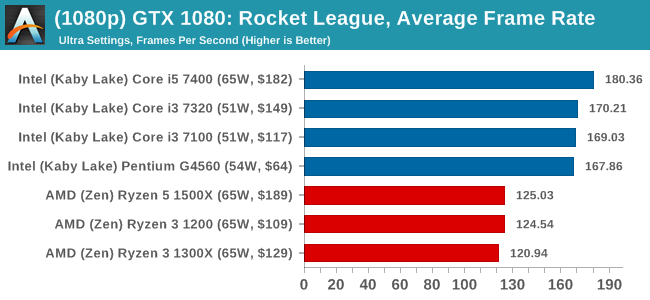
1080p



4K
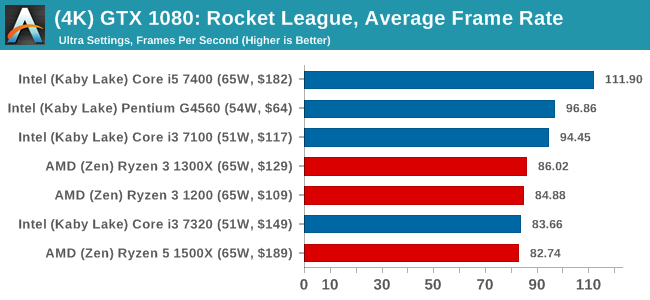
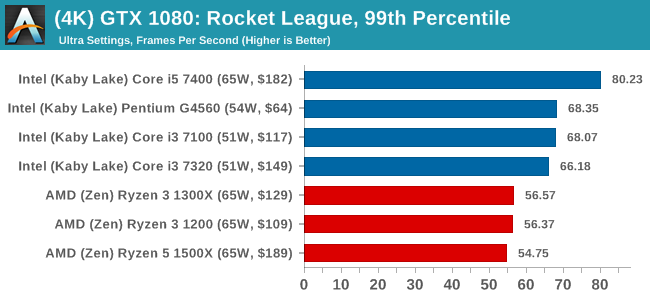
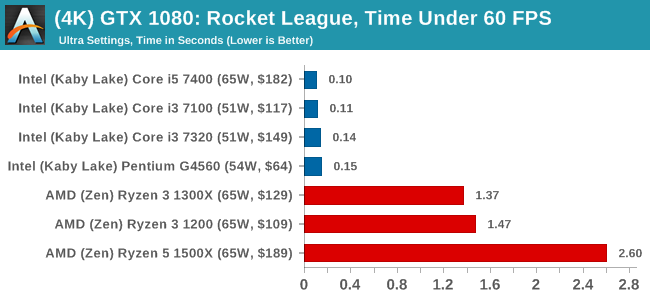
ASUS GTX 1060 Strix 6GB Performance
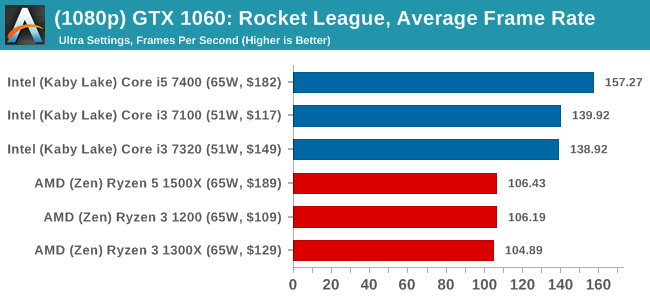
1080p


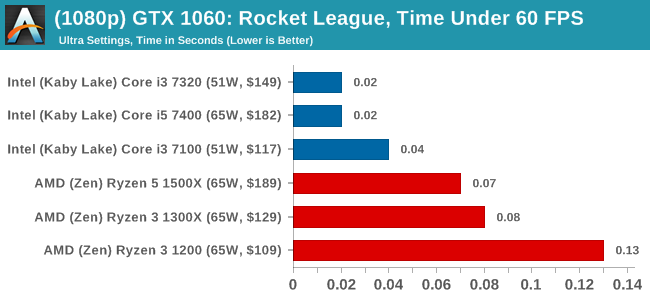
4K
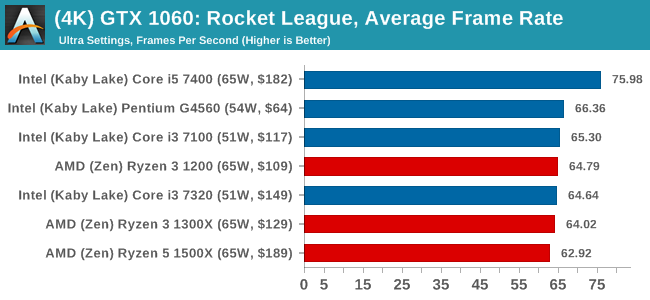
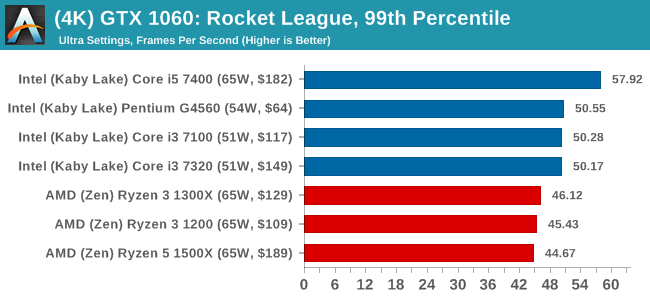
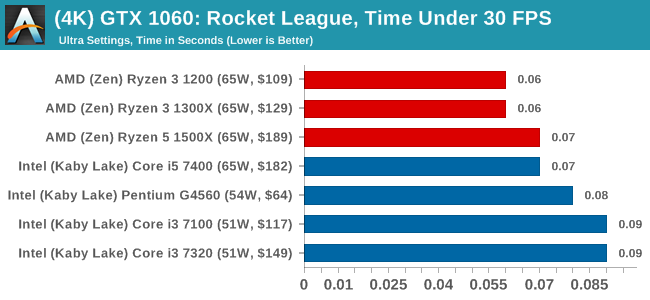
Sapphire R9 Fury 4GB Performance
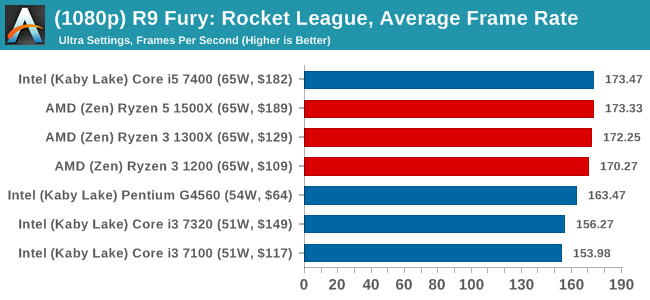
1080p


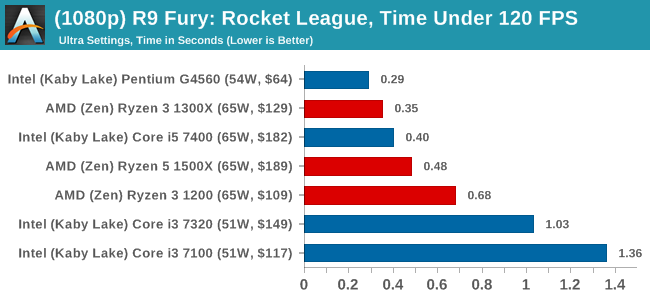
4K
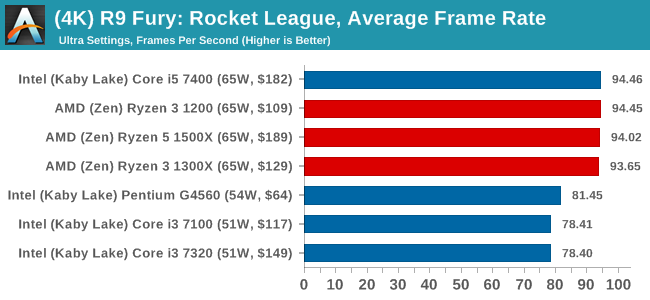

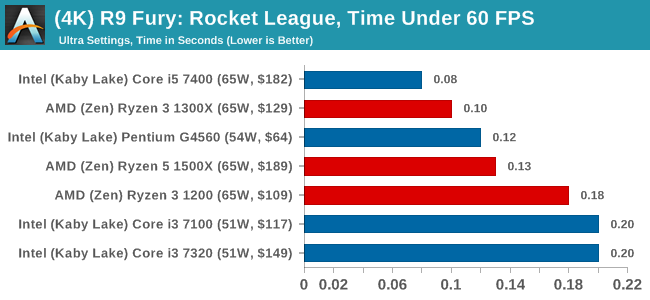
Sapphire RX 480 8GB Performance
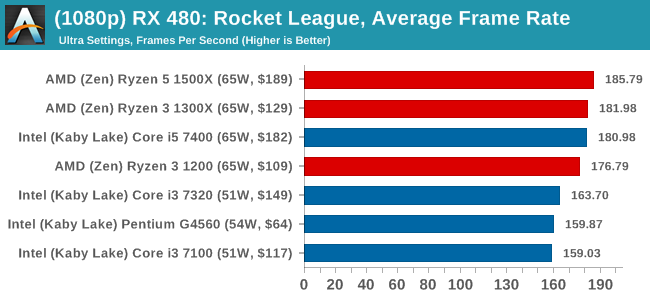
1080p

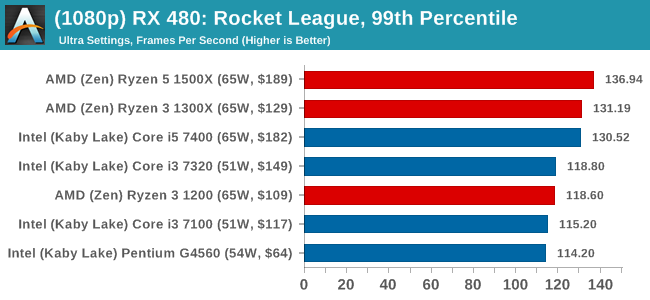
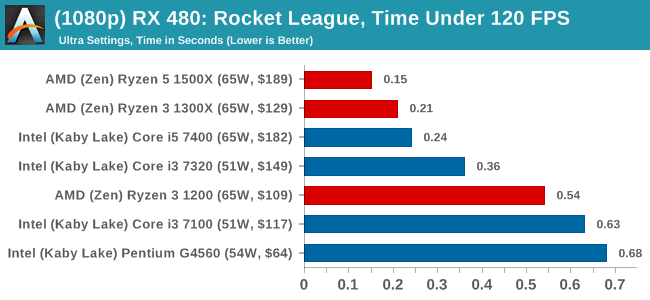
4K
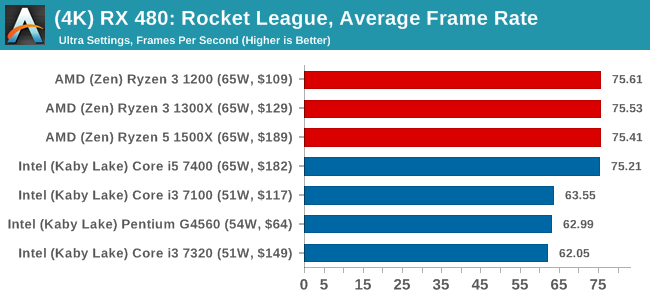
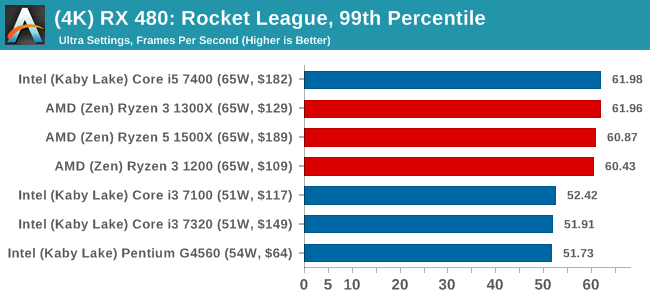
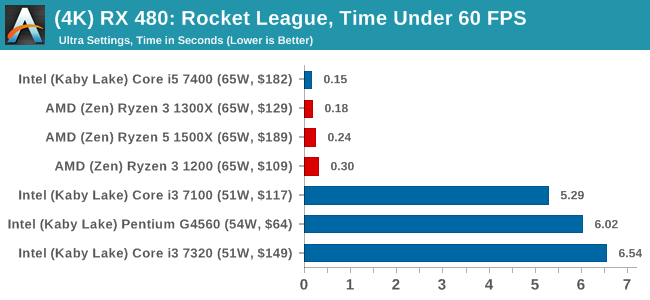
Rocket League Notes on GTX
The map we use in our testing, Aquadome, is known to be strenuous on a system, hence we see frame rates lower than what people expect for Rocket League - we're trying to cover the worst case scenario. But the results also show how AMD CPUs and NVIDIA GPUs do not seem to be playing ball with each other, which we've been told is likely related to drivers.


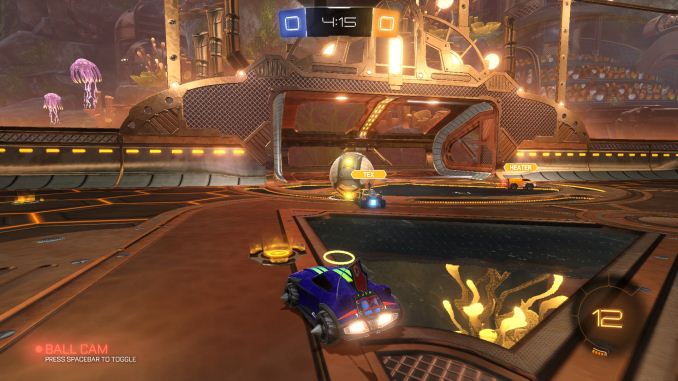
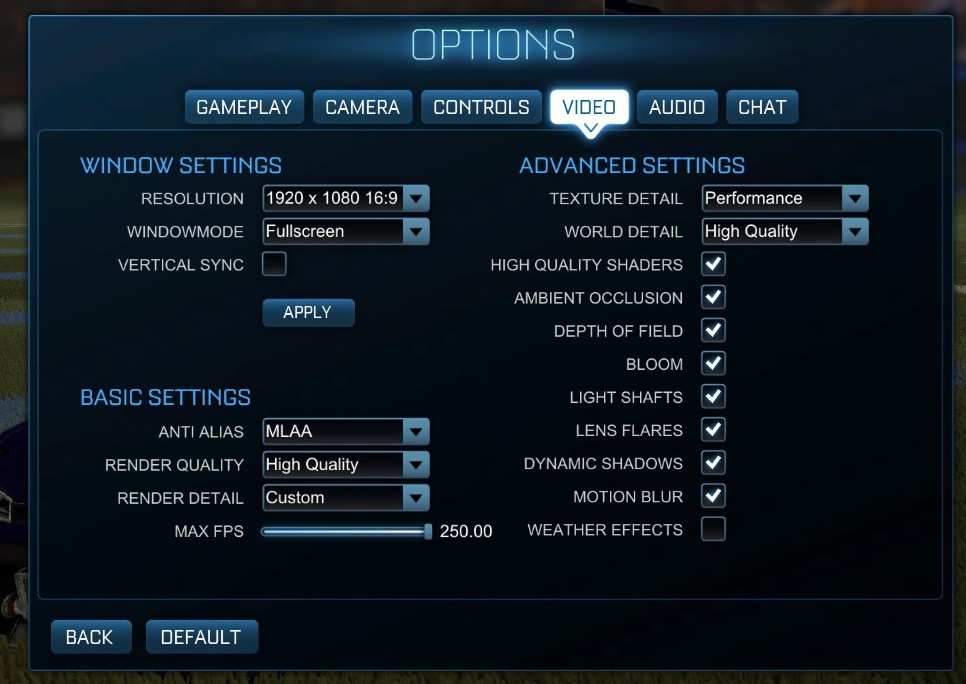








140 Comments
View All Comments
dave_the_nerd - Thursday, July 27, 2017 - link
Yes, obviously. That would be terrible.Oxford Guy - Thursday, July 27, 2017 - link
I'm glad you're not a tech reviewer. You could just say "Obviously" for every technical detail and that would be your article.Gothmoth - Thursday, July 27, 2017 - link
you can overclock the cheap AMD cpus... what about the intels?i am to lazy to check but are the testets intels k models? i guess not.
ddhelmet - Friday, July 28, 2017 - link
One thing I am really curious about is Citra performance. It would be an important test for single thread performance. All about that IPC.serendip - Friday, July 28, 2017 - link
Sorry but I don't see the point of these chips. An i3 is supposed to be a cheap do-everything CPU for basic business and school PCs. The Ryzen 3 not having a GPU really hurts its chances in those segments and it probably won't get picked up by OEMs. AMD needs mass market sales right now and Ryzen APUs can't come soon enough.I'm also wondering if yields are good enough that Ryzen 7s are the main chips being produced, with few 5s and 3s left over from the 7s that didn't meet spec.
Outlander_04 - Saturday, July 29, 2017 - link
The core count of the Ryzen chips is going to be a significant advantage over any dual core .Adding a basic graphics card will cost about $30 . For that you free up system RAM that the onboard would otherwise be using, and you get decent drivers that let you make some adjustments that intel removed when they dumbed down their drivers a few years back
serendip - Saturday, July 29, 2017 - link
Yeah but most office tasks run fine on 2 cores. Most users probably won't even notice they're using quad core processor.That $30 extra is a lot when it comes to speccing thousands of machines. A cheap discrete GPU is also another potential point of failure that large enterprises might not want on a big rollout. I understand the enthusiast reasoning for a cheap but powerful CPU like the Ryzen 3 paired with a decent midrange card, but this setup doesn't make sense for large corporate orders. AMD needs to sell lots of chips to large clients to survive.
Outlander_04 - Saturday, July 29, 2017 - link
It's not just the "Office tasks". Its the network services, antivirus and updating that goes on in what should be the background, but is not when you have a dual-core. I speak from experience. The HP desktops we have at work can be frustrating.buxe2quec - Friday, July 28, 2017 - link
Posting a review with placeholders for the benchmarks is definitely not professional.Delay it two days and post it in full, or split it in two reviews.
Looks like clickbaiting...
supdawgwtfd - Friday, July 28, 2017 - link
Ian. Your a shill. Or you just completely biased.Every single other review i have read has said the Ryzen 3 it the better option. In price and performance.
WTF has happened to Anandtech? Why are you guys spewing BS? Why can't you be unbiased?
Seriously?
Have been reading the site for almost 20 years. I think i will now have to officially NOT come here again...